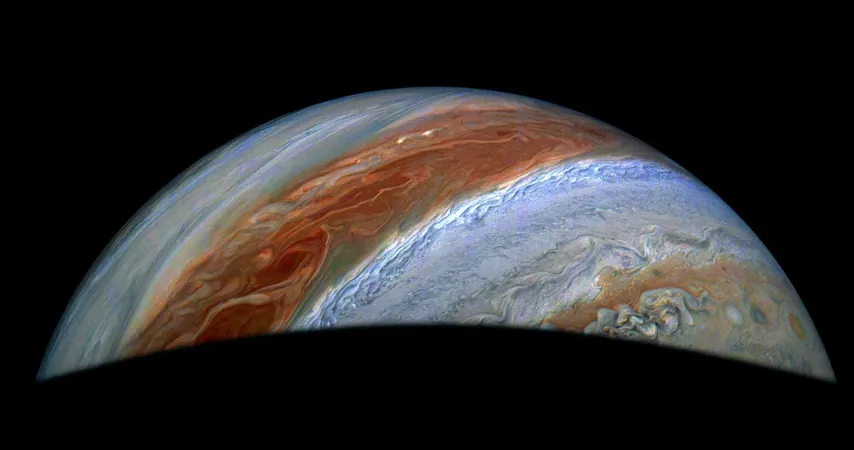
Unveiling the Mysteries of Jupiter and Io: NASA's Juno Mission Breaks New Ground
2025-04-29
Author: Yu
NASA's Juno mission is revolutionizing our understanding of the massive gas giant Jupiter and its volcanic moon, Io, with groundbreaking new data. Recently, scientists revealed mind-blowing insights into Jupiter’s fierce winds and cyclones, along with the bubbling volcanic activity beneath Io’s surface.
At a recent presentation at the European Geosciences Union General Assembly in Vienna, researchers announced that Juno’s observations have paved the way for a comprehensive model detailing the fast-moving jet streams swirling around Jupiter's cyclone-infested north pole. For the first time, they’ve also mapped Io's subsurface temperature profile, shedding light on the moon's inner structure and its turbulent volcanic landscape.
Scott Bolton, Juno's principal investigator at the Southwest Research Institute, highlighted the extremes of both celestial bodies, describing Jupiter as a relentless powerhouse of colossal polar cyclones, roaring jet streams, and breathtaking auroras. He emphasized that every new Juno orbit unveils further astonishing revelations about Jupiter's complex energy system.
Deep Insights with Advanced Technology
Utilizing Juno’s microwave radiometer (MWR), originally intended to explore Jupiter's cloudy exterior, scientists delved into Io. By merging MWR data with infrared images from the Jovian Infrared Auroral Mapper (JIRAM), they were astounded to discover evidence of still-warm magma lurking just beneath Io’s surface. Remarkably, around 10% of the moon's crust shows remnants of cooling lava—insights that explain why Io can renew its surface at such a rapid pace.
According to Juno scientist Shannon Brown, Io’s volcanic features function like a car radiator, efficiently whisking heat from the moon's depths to space, ensuring its fiery surface remains active.
Active Volcanoes Still Erupting
The excitement doesn't stop there. Juno's observations point to ongoing volcanic activity on Io, with one of the most energetic eruptions in the moon’s history still spitting lava and ash just days prior, bolstering expectations for continued eruptions during future flybys.
Exploring Jupiter's Atmosphere
On its 53rd orbit, Juno initiated radio occultation experiments that allow scientists to examine Jupiter’s atmospheric temperature structure. By sending radio signals through the gas giant’s layers, researchers can glean precise information about temperature and density. Initial findings reveal a surprisingly cool polar stratospheric cap, measuring approximately 11°C chillier than surrounding areas, with winds reaching speeds over 100 mph.
Polar Cyclones in Focus
The research team has also been tracking the monstrous cyclones swirling around Jupiter's north. Juno’s long-term data has showcased the dynamic nature of these colossal storms, unlike Earth’s isolated hurricanes. These polar cyclones cluster together and exhibit unique behavior as they interact with one another, reminiscent of springs in a mechanical system. Such findings offer not just a deeper understanding of Jupiter but could also inform our knowledge of atmospheric dynamics on other planets, including Earth.
As Juno continues its mission, the data gathered promises to deepen our appreciation of the universe's wonders. Bolton remarked, "With every new orbit, Juno takes us to places we’ve never been before, unlocking secrets hidden in the strongest planetary radiation belts in the solar system. Each mission is both adventurous and enlightening.”



 Brasil (PT)
Brasil (PT)
 Canada (EN)
Canada (EN)
 Chile (ES)
Chile (ES)
 Česko (CS)
Česko (CS)
 대한민국 (KO)
대한민국 (KO)
 España (ES)
España (ES)
 France (FR)
France (FR)
 Hong Kong (EN)
Hong Kong (EN)
 Italia (IT)
Italia (IT)
 日本 (JA)
日本 (JA)
 Magyarország (HU)
Magyarország (HU)
 Norge (NO)
Norge (NO)
 Polska (PL)
Polska (PL)
 Schweiz (DE)
Schweiz (DE)
 Singapore (EN)
Singapore (EN)
 Sverige (SV)
Sverige (SV)
 Suomi (FI)
Suomi (FI)
 Türkiye (TR)
Türkiye (TR)
 الإمارات العربية المتحدة (AR)
الإمارات العربية المتحدة (AR)